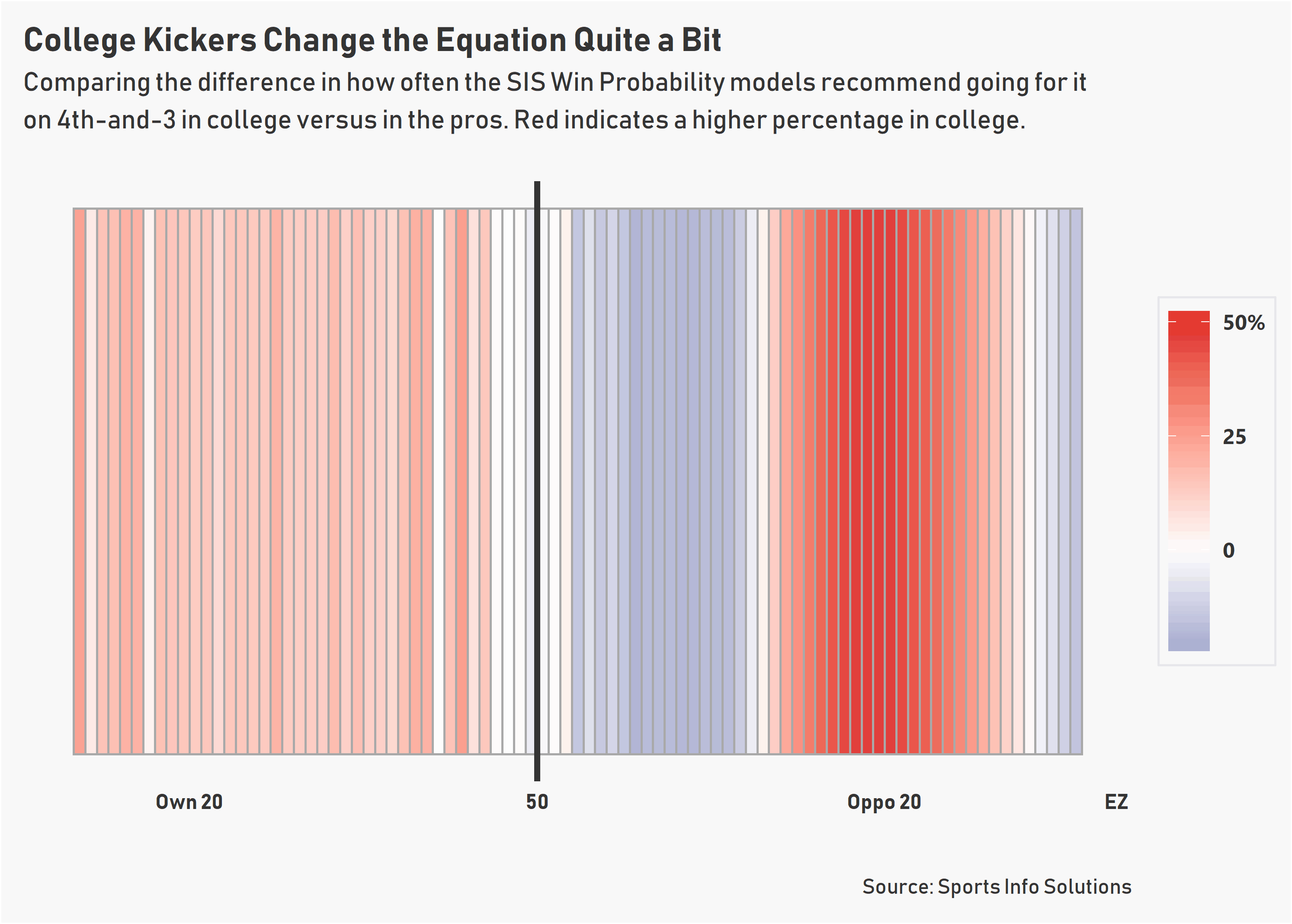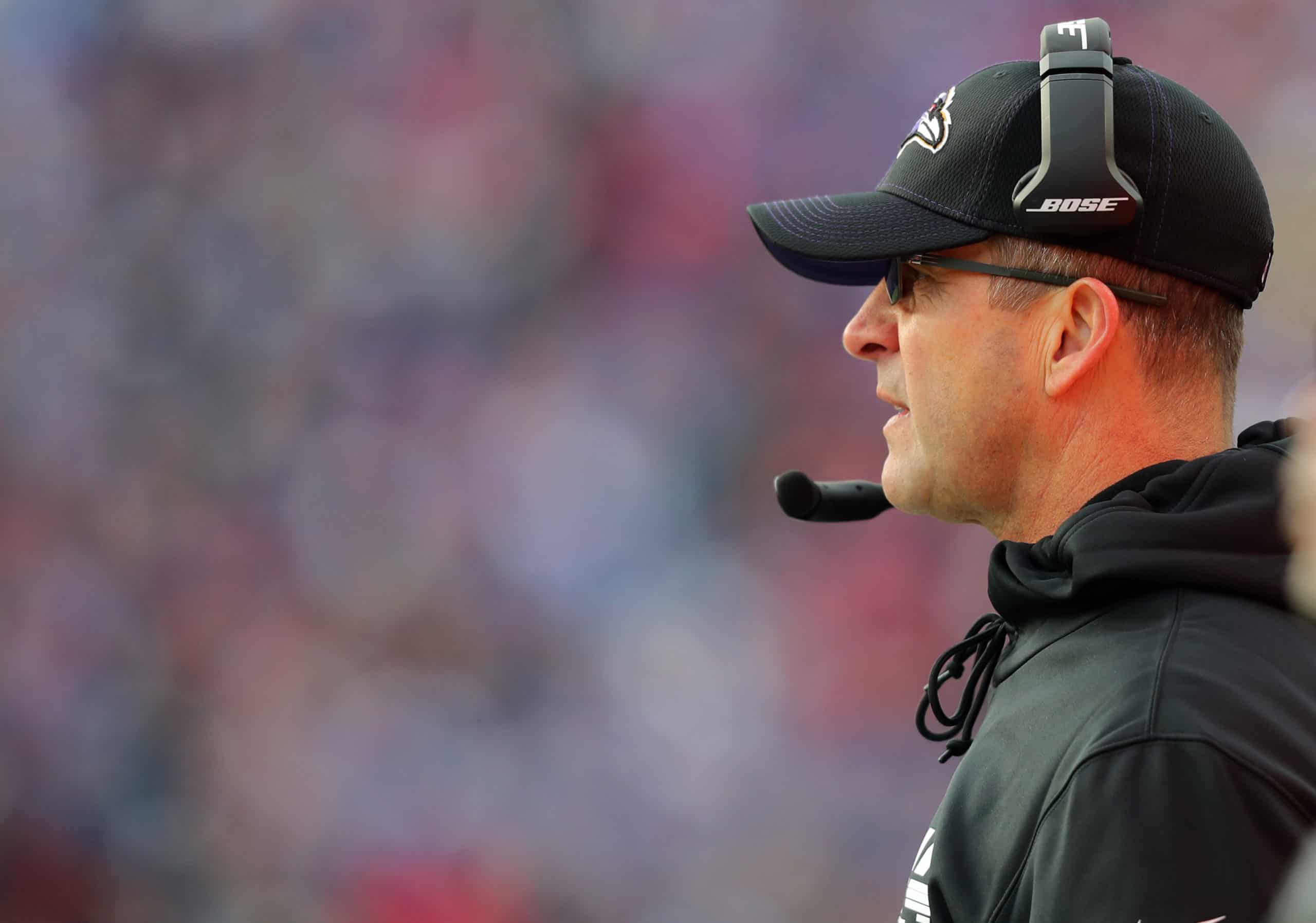Fourth down decision making has been put under a microscope more than ever this season. While teams like the Ravens have made a habit of going for it in 4th-and-short situations regardless of the score or where they are on the field, there are still a lot of teams who have been slow on the uptake.
More teams each year are hiring analytics-savvy people in prominent roles and dedicating more time and resources to analytics departments and researchers. But it may also benefit teams to do something they’ve done so often for other ideas—watch college football.
Looking at the last four years, including only plays between 10% and 90% win probability, NCAA teams have gone for it in 4th-and-3 or fewer from plus territory 65% of the time—a stark contrast to the NFL, where coaches have gone for it about 45% of the time. NCAA coaches are also far more willing to go for it on 4th-and-short from their own side of the field. On 4th-and-3 or fewer from their own side of the 50, college coaches have elected to go for it 16% of the time, compared to 9% in the NFL.
Go-For-It Rates in 4th-and-3 or Fewer by Side of Field
2016-2019, Win Probability between 10 and 90%
| Own | Opposition | |
|---|---|---|
| NCAA | 16% | 65% |
| NFL | 9% | 45% |
To the credit of the coaches, NFL teams appear to moving in the right direction. In plus territory in 2019 teams have gone for it on 4th-and-3 or fewer 56% of the time, up 11 percentage points from their four-year average. The number in their own territory is also higher than it has been overall, sitting at 15%. But while the trends in the NFL are encouraging, there is still a long way to go, and there is still a lot of value being left on the board.
Why are college teams more aggressive?
To look at this, we can create a hypothetical set of situations for both college and pro that includes all possible combinations of field position, time remaining, timeouts and score differential within a single touchdown—a little over four million situations in total. From there, we can use Sports Info Solutions’ win probability models to calculate the expected win probability if a team were to go for it, attempt a field goal, or punt from each yard line, and calculate how often the model would recommend going for it. To remove instances where the situation was closer to a toss-up, we will only consider going for it the optimal decision when it was the right call by more than a full percentage point.
Overall, in 4th-and-2 or fewer, the models make very similar recommendations between college and pro—go for it. But as has been the case before, patterns start to emerge when looking at 4th-and-3.

While the decision between kicking a field goal and going for it with three yards to go can be difficult in the NFL, that is not the case in college. Because of the lower success rate of college kickers, going for it on 4th-and-3 is a much more straightforward decision. In fact, up until about five yards to go, the decision to go for it in college is pretty clear cut.
In a much less drastic way, the model is also slightly more likely to recommend going for it from your own side of midfield in college. This again can be attributed to the quality of the specialist as the average net punt yardage in college is slightly lower across the board, causing the model to recommend going for it a bit more often. But even still, the model recommends going for it from your own side of the field well under 50% of the time, and generally only in late-and-trailing situations.
What can NFL teams take from this?
Even though the differences in decision making between the NFL and NCAA can mostly be explained away by the quality of specialists, there is still plenty of relevant information that can be gleaned from this for NFL teams.
When looking at all situations, the decision to go for it or attempt a field goal is very close to a toss-up in 4th-and-3. And that assumes a league-average kicker, which the 2019 season has made abundantly clear not all teams have. If nothing else, looking at how the model behaves in college can show how the quality of your kicker can move the needle on what the optimal decision is, and also shows that plenty of teams should be going for it in these situations more frequently.
This can also be shown using Net Drive Points. Focusing on plays between the 25 and 40-yard line where field goal attempts become less automatic in the pros, teams that go for it are averaging 1.8 points per drive, and teams that attempt the field goal are averaging only 1.7. On its own, this isn’t enough to say one way or another what a team should do in these situations, but rather another bit of evidence that shows just how thin the margins can be, and how impactful kicker quality is. While going for it on 4th down from inside field goal range is often looked at as an aggressive move, there are plenty of reasons why it is just as sound of a decision analytically as attempting a field goal, and understanding all of the moving parts that go into that is crucial when it comes to making optimal decisions.
















